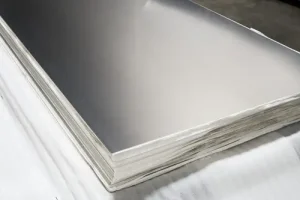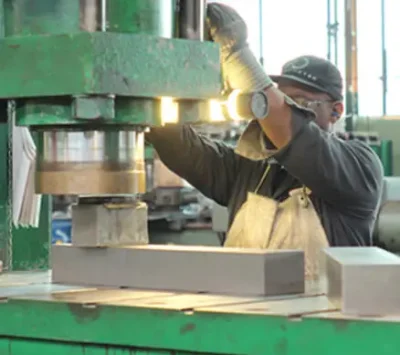مجموع: ۲,۲۶۴,۰۰۰ تومان
رسانه نیتاتجهیز
مجموع: ۲,۲۶۴,۰۰۰ تومان

Most Widely Used Austenitic Stainless Steel Modified with a Controlled Carbon Chemistry for Increased Strength to 1500°F (816°C).
Alloy 304/304H (UNS S30400/ S30409) is a modification of the most widely utilized “18-8” chromium-nickel austenitic stainless steel. The carbon content is controlled in the range of 0.04-0.10% for increased strength at temperatures above 800°F (427°C). It is an economical and versatile corrosion resistant alloy suitable for a wide range of general purpose applications.
It is common practice for 304H to be dual certified as 304 and 304H. The high carbon chemistry of 304H enables 304 to meet the mechanical properties and grain size requirements of 304H.
Alloy 304/304H has general corrosion resistance similar to 304/304L. It resists atmospheric corrosion, as well as, moderately oxidizing and reducing environments. However, because of its high carbon content, Alloy 304/304H is subject to carbide precipitation in the heat affected zone of welds.
Alloy 304/304H is non-magnetic in the annealed condition, but can become slightly magnetic as a result of cold working or welding. It can be easily welded and processed by standard shop fabrication practices.

ASTM…………………….. A 240
ASME…………………….. SA 240
AMS ……………………… 5513
QQ-S …………………….. 766
Alloy 304/304H has good resistance to atmospheric corrosion, foods and beverages and to many organic and inorganic chemicals in moderately oxidizing to moderately reducing environments. The high chromium content of the alloy provides resistance to oxidizing solutions such as nitric acid up to 55% weight and up to 176°F (80°C).
Alloy 304/304H also resists moderately aggressive organic acids such as acetic. The nickel present in the alloy provides resistance to moderately reducing solutions such as pure phosphoric acid, whatever the concentration, in cold solutions and up to 10% diluted hot solutions. The alloy can also operate successfully in caustic solutions free of chlorides or fluorides at moderate temperatures.
Alloy 304/304H does not perform well in more highly reducing environments such as those containing chlorides and sulfuric acid.
Alloy 304/304H performs well in fresh water service with low levels of chlorides (less than 100ppm). At higher chloride levels the grade is susceptible to crevice corrosion and pitting. For successful performance under these more severe conditions, higher molybdenum content is need such as 316/316L. Alloy 304/304H is not recommended for service in marine environments.
In most instances, the corrosion resistance of Alloys 304, 304L and 30H will be roughly equal in most corrosive environments. However, in environments that are sufficiently corrosive to cause intergranular corrosion of welds and heat-affected zones Alloy 304L should be used because of its low carbon content.
Lowest Temperature (°F) at Which the Corrosion Rate Exceeds 5mpy
| CORROSION ENVIRONMENT | Type 304/304H | Type 316L | 2205 (UNS S32205) | 2507 |
|---|---|---|---|---|
| 0.2% Hydrochloric Acid | >Boiling | >Boiling | >Boiling | >Boiling |
| 1% Hydrochloric Acid | 86p | 86 | 185 | >Boiling |
| 10% Sulfuric Acid | — | 122 | 140 | 167 |
| 60% Sulfuric Acid | — | <54 | <59 | <57 |
| 96% Sulfuric Acid | — | 113 | 77 | 86 |
| 85% Phosphoric Acid | 176 | 203 | 194 | 203 |
| 10% Nitric Acid | >Boiling | >Boiling | >Boiling | >Boiling |
| 65% Niitric Acid | 212 | 212 | 221 | 230 |
| 80% Acetic Acid | 212p | >Boiling | >Boiling | >Boiling |
| 50% Formic Acid | ≤50 | 104 | 194 | 194 |
| 50% Sodium Hydroxide | 185 | 194 | 194 | 230 |
| 83% Phosphoric Acid + 2% Hydrofluoric Acid | 113 | 149 | 122 | 140 |
| 60% Nitric Acid + 2% Hydrocloric Acid | >140 | >140 | >140 | >140 |
| 50% Acetic Acid + 50% Acetic Anhydride | >Boiling | 248 | 212 | 230 |
| 1% Hydrochloric Acid + 0.3% Ferric Chloride | 68p | 77p | 113ps | 203ps |
| 10% Sulfuric Acid + 2000ppm Cl- + N2 | — | 77 | 95 | 122 |
| 10% Sulfuric Acid + 2000ppm Cl- + SO2 | — | <<59p | <59 | 104 |
| WPA1, High Cl- Content | <<50 | ≤50 | 113 | 203 |
| WPA2, High F- Content | <<50 | ≤50 | 140 | 167 |
ps = pitting can occur
ps = pitting/crevice corrosion can occur
| WPA | P2O5 | CL- | F- | H2SO4 | Fe2O3 | Al2O3 | SiO2 | CaO | MgO |
|---|---|---|---|---|---|---|---|---|---|
| 1 | 54 | 0.20 | 0.50 | 4.0 | 0.30 | 0.20 | 0.10 | 0.20 | 0.70 |
| 2 | 54 | 0.02 | 2.0 | 4.0 | 0.30 | 0.20 | 0.10 | 0.20 | 0.70 |
Weight % (all values are maximum unless a range is otherwise indicated)
| Element | 304 | 304H |
|---|---|---|
| Chromium | 18.0 min.-20.0 max. | 18.0 min.-20.0 max. |
| Nickel | 8.0 min.-10.5 max. | 8.0 min.-10.5 max. |
| Carbon | 0.08 | 0.04 min-0.10 max. |
| Manganese | 2.00 | 2.00 |
| Phosphorus | 0.045 | 0.045 |
| Sulfer | 0.030 | 0.030 |
| Silicon | 0.75 | 0.75 |
| Nitrogen | 0.10 | 0.10 |
| Iron | Balance | Balance |
Thermal Conductivity 212°F (100°C)9.4 BTU/hr/ft2/ft/°F16.3 W/m-°K Melting Range25050 – 2590°F1398 – 1421°C Electrical Resistivity29.1 Microhm-in at 68°C74 Microhm-cm at 20°C | Density0.285 lbs/in37.90 g/cm3 Specific Heat0.12 BTU/lb-°F (32 – 212°F)500 J/kg-°K (0 – 100°C) Modulus of Elasticity29.0 x 106 psi200 GPa |
Mean Coefficient of Thermal Expansion
| Temperature Range | |||
|---|---|---|---|
| °F | °C | in/in °F | cm/cm °C |
| 68-212 | 20-100 | 9.2 x 10-6 | 16.6 x 10-6 |
| 68-932 | 20-500 | 10.0 x 10-6 | 18.0 x 10-6 |
| 68-1600 | 20-870 | 11.0 x 10-6 | 19.8 x 10-6 |
| ASTM | |||
|---|---|---|---|
| Typical* | Type 304 | Type 304H | |
| 0.2% Offset Yield Strength, ksi | 43 | 30 min. | 30 min. |
| Ultimate Tensile Strength, ksi | 91 | 75 min. | 70 min. |
| Elongation in 2 inches, % | 58 | 40 min. | 40 min. |
| Reduction in Area, % | 68 | — | — |
| Hardness, Rockwell B | 83 | 92 max. | 92 max. |
*0.375 inch plate
Alloy 304/304L can be easily welded and processed by standard shop fabrication practices.
Working temperatures of 1652–2102°F (750–1150°C) are recommended for most hot working processes. For maximum corrosion resistance, the material should be annealed at 1900°F (1038°C) minimum and water quenched or rapidly cooled by other means after hot working.
The alloy is quite ductile and forms easily. Cold working operations will increase the strength and hardness of the alloy and might leave it slightly magnetic.
Alloy 304/304L is subject to work hardening during deformation and is subject to chip breaking. The best machining results are achieved with slower speeds, heavier feeds, excellent lubrication, sharp tooling and powerful rigid equipment.
| Operation | Tool | Lubrication | CONDITIONS | |||||
|---|---|---|---|---|---|---|---|---|
| Depth-mm | Depth-in | Feed-mm/t | Feed-in/t | Speed-m/min | Speed-ft/min | |||
| Turning | High Speed Steel | Cutting Oil | 6 | .23 | 0.5 | .019 | 13-18 | 42.6-59 |
| Turning | High Speed Steel | Cutting Oil | 3 | .11 | 0.4 | .016 | 20-25 | 65.6-82 |
| Turning | High Speed Steel | Cutting Oil | 1 | .04 | 0.2 | .008 | 26-31 | 85.3-101.7 |
| Turning | Carbide | Dry or Cutting Oil | 6 | .23 | 0.5 | .019 | 75-85 | 246-278.9 |
| Turning | Carbide | Dry or Cutting Oil | 3 | .11 | 0.4 | .016 | 90-100 | 295.3-328.1 |
| Turning | Carbide | Dry or Cutting Oil | 1 | .04 | 0.2 | .008 | 110-120 | 360.8-393.7 |
| Depth of cut-mm | Depth of cut-in | Feed-mm/t | Feed-in/t | Speed-m/min | Speed-ft/min | |||
| Cutting | High Speed Steel | Cutting Oil | 1.5 | .06 | 0.03-0.05 | .0012-.0020 | 18-23 | 59-75.5 |
| Cutting | High Speed Steel | Cutting Oil | 3 | .11 | 0.04-0.06 | .0016-.0024 | 19-24 | 62.3-78.7 |
| Cutting | High Speed Steel | Cutting Oil | 6 | .23 | 0.05-0.07 | .0020-.0027 | 20-25 | 65.6-82 |
| Drill ø mm | Drill ø in | Feed-mm/t | Feed-in/t | Speed-m/min | Speed-ft/min | |||
| Drilling | High Speed Steel | Cutting Oil | 1.5 | .06 | 0.02-0.03 | .0007-.0012 | 10-14 | 32.8-45.9 |
| Drilling | High Speed Steel | Cutting Oil | 3 | .11 | 0.05-0.06 | .0020-.0024 | 12-16 | 39.3-52.5 |
| Drilling | High Speed Steel | Cutting Oil | 6 | .23 | 0.08-0.09 | .0031-.0035 | 12-16 | 39.3-52.5 |
| Drilling | High Speed Steel | Cutting Oil | 12 | .48 | 0.09-0.10 | .0035-.0039 | 12-16 | 39.3-52.5 |
| Feed-mm/t | Feed-in/t | Speed-m/min | Speed-ft/min | |||||
| Milling Profiling | High Speed Steel | Cutting Oil | 0.05-0.10 | .002-.004 | 12-22 | 39.4-72.2 | ||
Alloy 304/304L can be readily welded by most standard processes. A post weld heat treatment is not necessary.
NOTE: The information and data in this product data sheet are accurate to the best of our knowledge and belief, but are intended for informational purposes only, and may be revised at any time without notice. Applications suggested for the materials are described only to help readers make their own evaluations and decisions, and are neither guarantees nor to be construed as express or implied warranties of suitability for these or other applications. Stainless Steel, Nickel Alloy and Titanium products are classified as sheet if the thickness of the metals is less than 3/16” (4.7mm). If the thickness of the metal is 3/16” (4.7mm) or more, then it is considered a plate.
